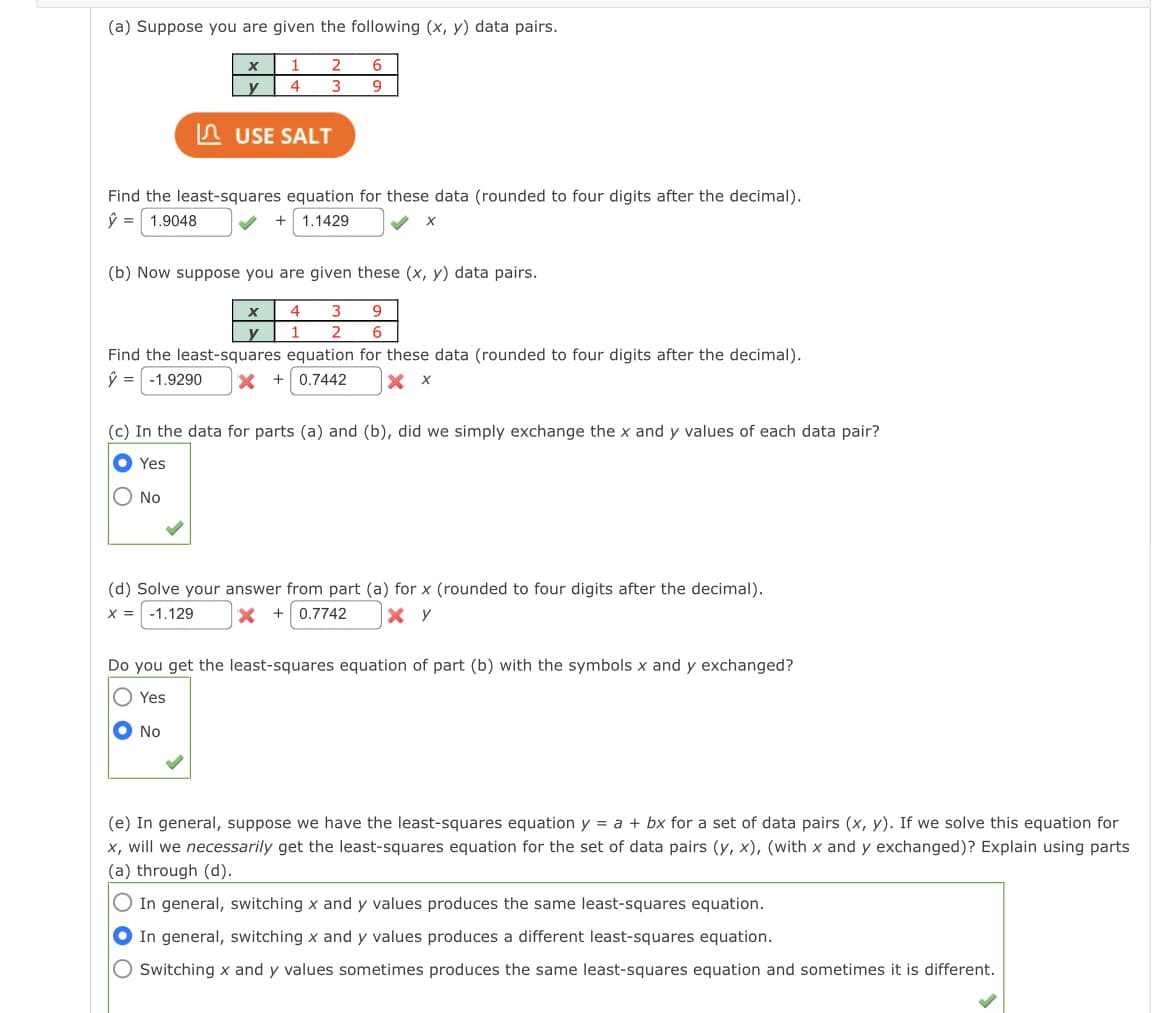(a) Suppose you are given the following (x, y) data pairs. 1 6 y 4 3 9 n USE SALT Find the least-squares equation for these data (rounded to four digits after the decimal). 1.9048 1.1429 (b) Now suppose you are given these (x, y) data pairs. 4 3 9. y 1 2 Find the least-squares equation for these data (rounded to four digits after the decimal). -1.9290 0.7442 (c) In the data for parts (a) and (b), did we simply exchange the x and y values of each data pair? Yes O No (d) Solve your answer from part (a) for x (rounded to four digits after the decimal). -1.129 0.7742 X Y %3D Do you get the least-squares equation of part (b) with the symbols x and y exchanged? O Yes No (e) In general, suppose we have the least-squares equation y = a + bx for a set of data pairs (x, y). If we solve this equation for x, will we necessarily get the least-squares equation for the set of data pairs (y, x), (with x and y exchanged)? Explain using parts (a) through (d). O In general, switching x and y values produces the same least-squares equation.
(a) Suppose you are given the following (x, y) data pairs. 1 6 y 4 3 9 n USE SALT Find the least-squares equation for these data (rounded to four digits after the decimal). 1.9048 1.1429 (b) Now suppose you are given these (x, y) data pairs. 4 3 9. y 1 2 Find the least-squares equation for these data (rounded to four digits after the decimal). -1.9290 0.7442 (c) In the data for parts (a) and (b), did we simply exchange the x and y values of each data pair? Yes O No (d) Solve your answer from part (a) for x (rounded to four digits after the decimal). -1.129 0.7742 X Y %3D Do you get the least-squares equation of part (b) with the symbols x and y exchanged? O Yes No (e) In general, suppose we have the least-squares equation y = a + bx for a set of data pairs (x, y). If we solve this equation for x, will we necessarily get the least-squares equation for the set of data pairs (y, x), (with x and y exchanged)? Explain using parts (a) through (d). O In general, switching x and y values produces the same least-squares equation.
Linear Algebra: A Modern Introduction
4th Edition
ISBN:9781285463247
Author:David Poole
Publisher:David Poole
Chapter7: Distance And Approximation
Section7.3: Least Squares Approximation
Problem 34EQ
Related questions
Question

Transcribed Image Text:(a) Suppose you are given the following (x, y) data pairs.
1
2
6
y
4
3
n USE SALT
Find the least-squares equation for these data (rounded to four digits after the decimal).
ý = 1.9048
1.1429
(b) Now suppose you are given these (x, y) data pairs.
4
3
9
y
1
2
6
Find the least-squares equation for these data (rounded to four digits after the decimal).
ý = -1.9290
0.7442
X X
(c) In the data for parts (a) and (b), did we simply exchange the x and y values of each data pair?
Yes
O No
(d) Solve your answer from part (a) for x (rounded to four digits after the decimal).
X = -1.12g
0.7742
X Y
Do you get the least-squares equation of part (b) with the symbols x and y exchanged?
O Yes
No
(e) In general, suppose we have the least-squares equation y = a + bx for a set of data pairs (x, y). If we solve this equation for
x, will we necessarily get the least-squares equation for the set of data pairs (y, x), (with x and y exchanged)? Explain using parts
(a) through (d).
O In general, switching x and y values produces the same least-squares equation.
In general, switching x and y values produces a different least-squares equation.
Switching x and y values sometimes produces the same least-squares equation and sometimes it is different.
Expert Solution
This question has been solved!
Explore an expertly crafted, step-by-step solution for a thorough understanding of key concepts.
Step by step
Solved in 3 steps

Recommended textbooks for you

Linear Algebra: A Modern Introduction
Algebra
ISBN:
9781285463247
Author:
David Poole
Publisher:
Cengage Learning

Linear Algebra: A Modern Introduction
Algebra
ISBN:
9781285463247
Author:
David Poole
Publisher:
Cengage Learning